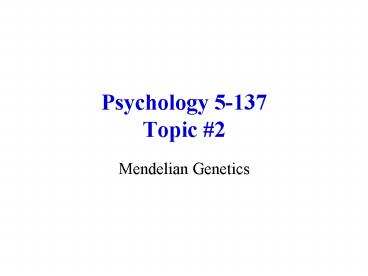Psychology 5137 Topic - PowerPoint PPT Presentation
1 / 36
Title: Psychology 5137 Topic
1
Psychology 5-137Topic 2
- Mendelian Genetics
2
Types of Genetic Influence
- Chromosomal
- Monogenic
- (Single-gene, mendelian)
- Multigenic
- (galtonian, multifactorial, polygenic, oligogenic
disorders with complex genetics) - Mitochondrial
3
(No Transcript)
4
Mendels Laws
- Law of Segregation
- Law of Independent Assortment
- Principles
- Inherited characteristics governed by a pair of
factors (genes) - One gene inherited from each parent
- Individual genes can come in alternative forms
(alleles), which can dominate in their expression
- In gametogenesis (meiosis) alleles segregate
independently - Transmission of alleles affecting different
characteristics is independent
5
Terminology
- Provisional definition of gene - sequence of DNA
whose primary purpose is the regulation of
protein synthesis - Genotype vs Phenotype
- Chromosomes threadlike structures on which
individual genes are located
6
Chromosome 9
- Locus (location) and allele (alternative form)
- Centromere, short (p) and long (q) arms
Centromere
p
q
ABO locus
(9q34.1)
7
Karyotype
8
Mitosis
- Process of somatic cell duplication in which a
cell produces two genetically identical daughter
cells. - Chromosomes usually visualized during metaphase
- Error nondisjunction of sister chromatids gives
rise to mosaicism.
9
(No Transcript)
10
Meiosis
- Process of gametic cell production
(gametogenesis) in which genetic material is
reduced by half (from diploid to haploid) - Error nondisjunction of homologous chromosomes
(aneuploidy) - Recombination (we will return to)
11
(No Transcript)
12
Anueploidy Trisomy 21
13
Mendelian Patterns of Inheritance
- Autosomal dominant (Huntington Disease)
- Autosomal recessive (PKU)
- X-linked recessive (Lesch-Nyhan)
- (X-linked dominant)
- (Y-linked holanderic)
14
Autosomal Dominant
- A single copy of the deviant gene is sufficient
to produce the disorder - AA Aa aa
- Affected Affected Unaffected
- Distinct familial pattern of familial
transmission.
15
(No Transcript)
16
Huntington Disease
- Variable age of onset ( anticipation)
- Variable expressivity
- Issues in molecular diagnostics
17
Huntington Disease
- Affects 1/20,000 individuals of European ancestry
- Mean age of onset is 35 years, range is neonate
to 70 years
18
(No Transcript)
19
Anticipation
- An inherited disorder whose age of onset gets
earlier and/or severity increases in successive
generations - HD unstable mutation (trinucleotide repeat
expansion but later)
20
Kirkwood et al. (2001) Archives of Neurology 58
273-278
21
Variable Expressivity
- Choreic Form
- Rigid Form
- Distinct phenotypic manifestations of the
disorder among individuals with the same genotype - Distinguish from genetic heterogeneity different
genotypes give rise to same phenotype
22
HD First Success of the Positional Cloning
Strategy?
- In 1983, HD gene locus was mapped to chromosome
4p (4p16.3) using linkage analysis. - In 1993, HD gene (proteinhuntingtin) was cloned.
Mutation is a variable number of CAG repeats
(trinucleotide repeat). Such that - lt 35 repeats Unaffected
- 36-39 repeats Possibly affected
- gt 40 repeats Affected
- It is an unstable mutation the number of
repeats can increase during meiois, especially
through dads.
23
Molecular Diagnostics
- Premobid Diagnosis (Predictive Testing)
- Prior to 1983 50/50 chance
- 1983 to 1993 Risk probability could be refined
- Currently Number of repeats can be quantified
24
Penetrance
- HD is completely penetrant because
- Genotype aa Aa AA
- Affected 0 100 100
- Reduced or incomplete penetrance
- Genotype aa Aa AA
- Affected 0 lt100 lt100
25
(No Transcript)
26
Phenylketonuria
- Nature of gene function
- Pleiotropy
- Genotype-environment interaction
27
Phenylketonuria
- 1/10,000 births among Western Northern
Europeans - Symptoms
- Severe mental retardation (if untreated)
- Irritable, hyperactive, subject to seizures
- Eczema hypopigmentaion
- Musty odor
28
Pleiotropy GxE Interaction
- Pleiotropy one gene can have multiple
phenotypic effects - Genotype-Environment Interaction (provisional) -
PKU phenotype only occurs when the necessary
genotype is reared in the obligate environment.
29
(No Transcript)
30
PKU A Public Health Success
- 1934 disorder inheritance pattern
- 1947 metabolic defect determined
- 1954 first successful treatment program
- 1963 Guthrie test developed
- Current All US states and many countries screen
for PKU
31
Treatment Issues
- When should treatment be initiated?
- When should treatment be terminated?
- Maternal PKU
32
X-linked Recessive
- Two copies of deviant gene in females but only
one copy is males is needed to develop the
disorder. - Females
Males - aa Aa AA a
A - Aff Un Un Affect
Unaff
33
(No Transcript)
34
Lesch-Nyhan Disease
- 1/380,000 births
- Developmental delay in sitting, crawling
- Low IQ
- Self mutilation
35
(No Transcript)
36
Summary
- Terminology, mitosis meiosis
- Huntington Disease
- Variable age of onset, anticipation
- Variable expressivity
- Molecular diagnostics
- (genetic heterogeneity, reduced penetrance)
- PKU
- Gene ? behavior
- Pleiotropy
- G x E interaction
- Lesch-Nyhan
- X-linkage
- No effective treatment






























